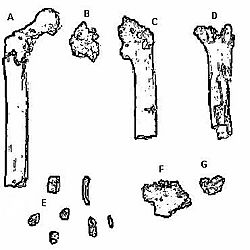Orrorin tugenensis facts for kids
Quick facts for kids OrrorinTemporal range: Miocene
|
|
|---|---|
 |
|
| Orrorin tugenensis fossils | |
| Scientific classification | |
| Kingdom: | |
| Phylum: | |
| Class: | |
| Order: | |
| Family: | |
| Subfamily: | |
| Genus: |
Orrorin
Senut et al., 2001
|
| Binomial name | |
| †Orrorin tugenensis Senut et al., 2001
|
|
Orrorin is an ancient relative of humans. It's thought to be the second-oldest human ancestor we know about! Only one type of Orrorin has been found, called Orrorin tugenensis.
Scientists found Orrorin fossils in a place called the Tugen Hills in Kenya, Africa. They named it after this location. These fossils are very old, dating back about 6.1 to 5.8 million years ago. This time period is known as the late Miocene epoch.
Contents
What is Orrorin?
Orrorin tugenensis is a very early hominin. Hominins are a group that includes modern humans and all our close fossil relatives. Finding Orrorin fossils helps us understand how humans evolved over millions of years.
Where Were the Fossils Found?
The fossils were discovered in the Tugen Hills of central Kenya. This area is famous for its ancient sites. Many important fossils that teach us about early human history have been found there.
How Old is Orrorin?
Scientists use special methods to figure out how old fossils are. They estimated that Orrorin lived between 6.1 and 5.8 million years ago. This makes it one of the earliest known hominins. It lived during a time called the late Miocene epoch.
Life of Orrorin
Scientists believe Orrorin was about the size of a modern chimpanzee. It likely lived in a forest environment. The shape of its leg bones suggests it could walk upright on two legs. This is a very important feature for early human ancestors.
What Did Orrorin Eat?
Based on its teeth, Orrorin probably ate a diet of fruits and vegetables. Its teeth were also good for chewing nuts and seeds. This varied diet helped it survive in its ancient forest home.
Discovering Orrorin
A team of scientists found the first Orrorin fossils in 2000. They were led by Brigitte Senut and Martin Pickford. Their discovery was very exciting for understanding human evolution.
Important Fossil Finds
The fossils found included parts of leg bones, arm bones, and teeth. The leg bones were especially important. They showed signs that Orrorin could walk upright. This is called bipedalism.
Related Topics
- Human timeline: See how Orrorin fits into the story of human evolution.
- In Spanish: Orrorin tugenensis para niños

